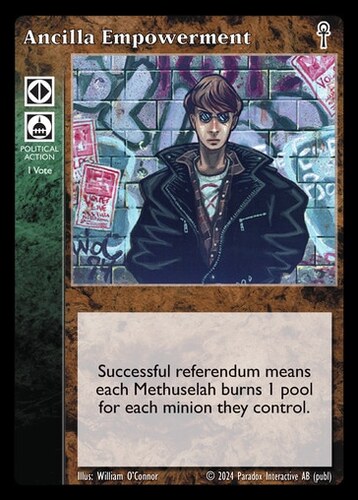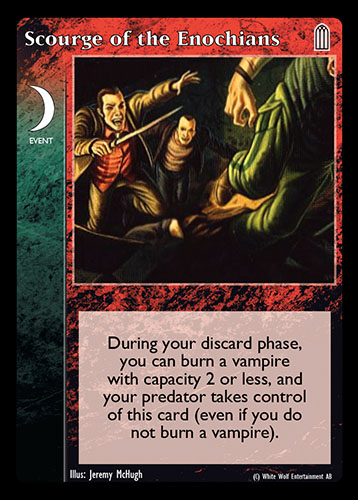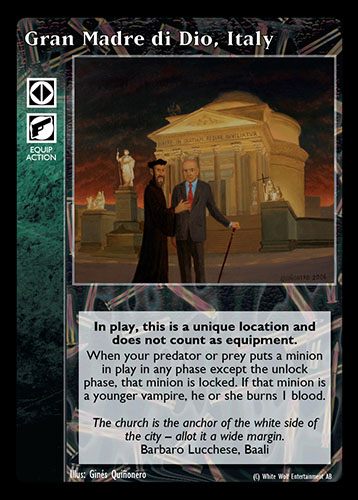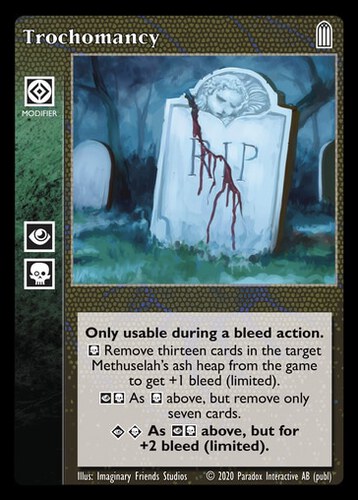Playing Tupdogs & Nephandus
By Tommi Hakomaa, translation by Tero Aalto.
I have never been much of a deck builder but I've always greatly enjoyed playing. When I was younger, I used considerably more time on this hobby by tinkering with decks of my own. However, I didn't do particularly well with my own designs. That's why these days, I practically always play decks created by way more talented deck builders than myself, only fine-tuning them to better fit my hand.
This particular deck won the Tour de Chauffe tournament for Martin Weinmayer in 2019. I have used it in multiple tournaments and occasionally made slight adjustments based on the metagame. My best results with this deck are the final of EC 2019 and winning the Garou Rim: Antediluvian Awakening tournament.
GW > VP
I consider one of the most important lessons of V:TES I've learnt along the years to be: always play for the GW, not for the VP. This is especially true for combat decks such as this one that aim at controlling the table instead of quickly reducing pool. This principle will occasionally lead you to miss out on a VP that you would have gotten had you gone for it. This is a small price to pay for winning tables more often than if you were simply trying to get one VP after another.
With this deck, your goal is to get 1 GW and from 2.5 to 4 VP. 1GW5 is certainly fine as well, but there's no point in forcing it. As long as 1 or 2 players are out of the game fast enough, you can typically be happy with the situation, even if it wasn't you who eliminated them. What does this mean in practice when playing this deck?
-
Categorize the opponents' decks as quickly as possible.
- How are they planning to oust their prey? Bleed, vote, something else?
- How are they trying to reach their goal? Stealth, swarm, multi action, etc.?
- Is the survival of one of these decks particularly detrimental to your game plan? Do you have to react to this deck already at an early stage, even when the player in question is not sitting next to you? A good example is a Ravnos Clown Car sitting cross table and not receiving proper pressure.
- At the early stages, plan how to eliminate two "extra" players. If needed, help your crosstable buddy to eliminate their prey, especially if you get something in return. Be open to all kinds of deals in general. This deck's power increases dramatically the fewer players are left at the table. But always be ready to reassess the situation.
- Weakening your own predator is a good early game strategy with this deck. Even though your vampires are cheap, you're going to invest some pool in them and Nephandi practically every turn.
Influence phase
First bring out Antonio, preferably accompanied by at least one Tupdog, depending on the situation. The probability to find an Antonio in your starting crypt is 61,7%. If there's no Antonio but some other Tremere antitribu i, bring them first instead. There's a 14,4% probability to start your game with four Tupdogs in your starting crypt. In this case, you'll have to dig for the missing Tremere antitribu i by influencing Tupdogs just to recycle them because they can't do anything without a Tremere antitribu i in this deck.
| Tupdogs recycled | Chance of a Tremere |
| 1 | 42.9% |
| 2 | 68.6% |
| 3 | 83.4% |
| 4 | 91.7% |
Under these circumstances, I recommend to bring out 2 or 3 Tupdogs. I usually bring two. Just one makes no sense for recycling purposes if you have four or more transfers. Paying one to see one costs the same as a Tupdog, and you don't lose the recycled vampire.
Tips for the influence phase
- Dreams of the Sphinx, Powerbase: Montreal and Information Highway allow you to both use Antonio's special and influence a Tupdog in the same turn.
- In a steady game situation it is usually good to influence out one Nephandus and one Tupdog (if you have the means). If you need more defence or attack power it is wise to influence out multiple Tupdogs. Just keep in mind that it is important to have those Nephandus to destroy torpored vampires.
Card flow
In V:TES, one of the most important qualities of a deck is good card flow. Without it, your hand stagnates easily and both the deck's power and your play options drop dramatically. In this deck, the large master module (~35% of the deck) poses the greatest single hand jam risk. That's why it's vital to always play a Parthenon as quickly as possible. Always use your discard phase action. Any cards you discard can be brought back several times over with Ashur Tablets. Dreams of the Sphinx also helps in looking for a Parthenon.
| Cards drawn | Chance of a Parthenon |
| 7 | 35% |
| 11 | 50% |
| 15 | 62% |
| 20 | 74% |
| 25 | 82% |
Tips for better card flow
- Play The Parthenon ASAP.
- Always discard.
- Use Dreams for cards.
- Antonio's special can also find a Nephandus in your hand.
Table Talk
Your deck is very aggressive but it doesn't mean you need to be. Try to avoid situations where you spew threats all over the table without being able to follow up on them. This will only make unnecessarily many players gang up against you. On the other hand, never accept any superfluous damage from the crosstable. Try to offer your crosstable other options instead, and if they do not like your options, you can threaten them with your torpedoes (Tupdogs). If you make a threat, don't go back on it, or you'll soon run out of credibility.
Listen to what the other players have to say to you. If they offer you a deal that will even just partially advance your goal, accept it. Generally, the faster the number of players drops from five to three, the better you're doing.
Cards that counter this deck and how to prepare for them

Anarchist Uprising
Ancilla Empowerment
This deck quickly accumulates 5+ minions, making these votes nasty. You have 2x Delaying Tactics and 1x Yawp Court to use against them. Add or subtract according to your local meta. In my experience, Yawp Court is very good anti-vote tech. I have increased their number to two for future games.

Scourge of the Enochians
Switching the Unmaskings out for Uncoilings is one option to consider. I wouldn't personally recommend it, though, because the lack of Unmaskings considerably weakens the deck's defense. When a Scourge is played, I typically start thinking how I could contribute to ousting the player controlling it to get rid of it.

Gran Madre di Dio, Italy
Rarely played but very problematic if played by your neighbor. Absolutely DI this one if you can. If you cannot, immediately use your Tupdogs to rush the minion it's on and Nephandi to burn it from torpor. Should you fail, a Haven Uncovered and a herd of Nephandi will do the trick later on. As long as this card remains in your neighborhood (on a 2+ cap vampire), there's no point in bringing out new Tupdogs, and a big part of your deck is equally useless.

Trochomancy
A real poison for this deck. There's no good way around this card as any vampire with inferior Necromancy can use it. If you get to play one against this deck, you can do the most damage by removing combat cards. Just one Trochomancy hurts a lot, and surviving two is basically impossible.
Final words
If you're like me in that you find deckbuilding a challenge, and it's holding you back in the game, I recommend studying other people's designs using the TWDA or Codex of the Damned. Try the Codex's Deck Search. It will show you for example all tournament winning decks with Tupdog, Nephandus and Yawp Court.

